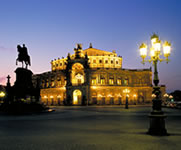Other highlights
Places of interest

Brandenburg Gate is Berlin's most famous landmark and a symbol of division overcome. For many years it stood in no man's land next to the Berlin Wall and was reopened on 22 December 1989, following the fall of the Wall. The Kaiser Wilhelm Memorial Church on Kurfürstendamm is a memorial to peace and reconciliation and symbol of Berlin's determination to rebuild during the post-war era.
The Reichstag is the German parliament building and, with its new glass cupola designed by Sir Norman Foster, has become one of Berlin's most popular attractions. The Federal Chancellery is one of the most impressive buildings in the newly built government quarter. The large white building is part of the "Band des Bundes", or "ribbon of government" that links the new buildings and creates an architectural dialogue with the historical Reichstag.
The painstakingly restored Hackesche Höfe courtyards are extremely popular with tourists and trendsetters alike. Consisting of a web of eight courtyards designed for living and working, the Hackesche Höfe form the largest complex of its kind in Germany. The complex was built in the late 18th/early 19th century and, like many such courtyards in Berlin, was a mix of offices, workshops, multi-storey factories (particularly in the buildings in front of the courtyards) and apartments.
Travel Planner
Select an option...
Map of Germany
Hotels in Berlin
Loading



